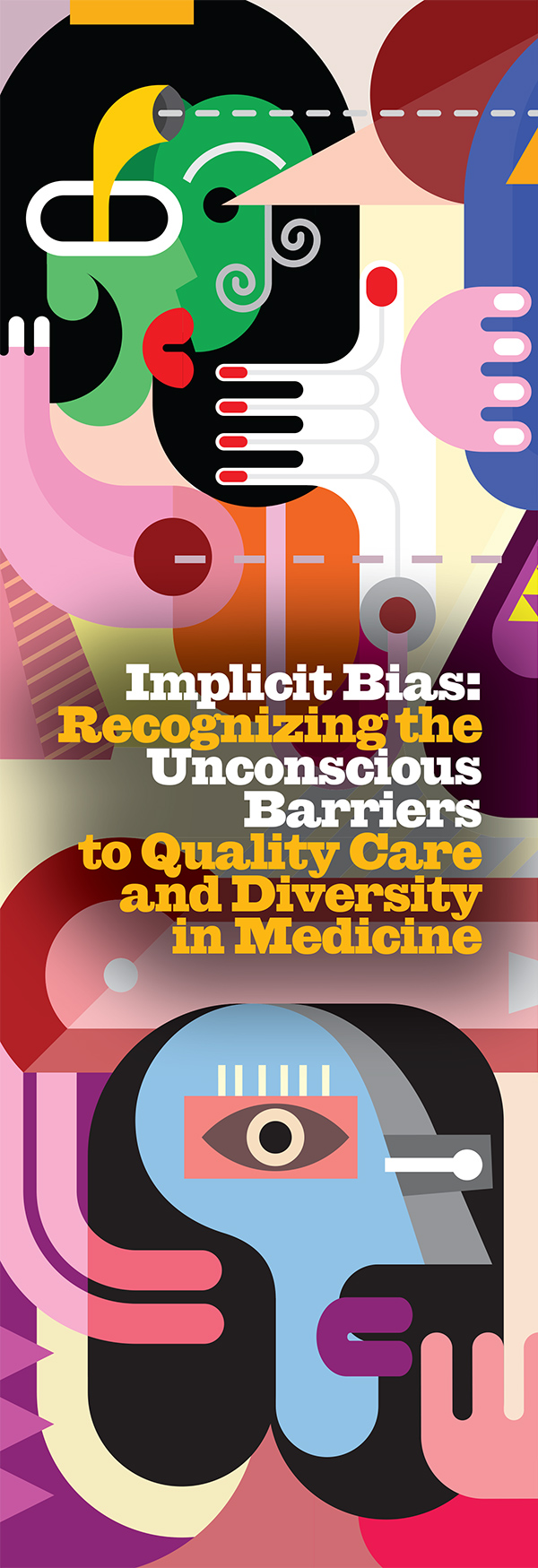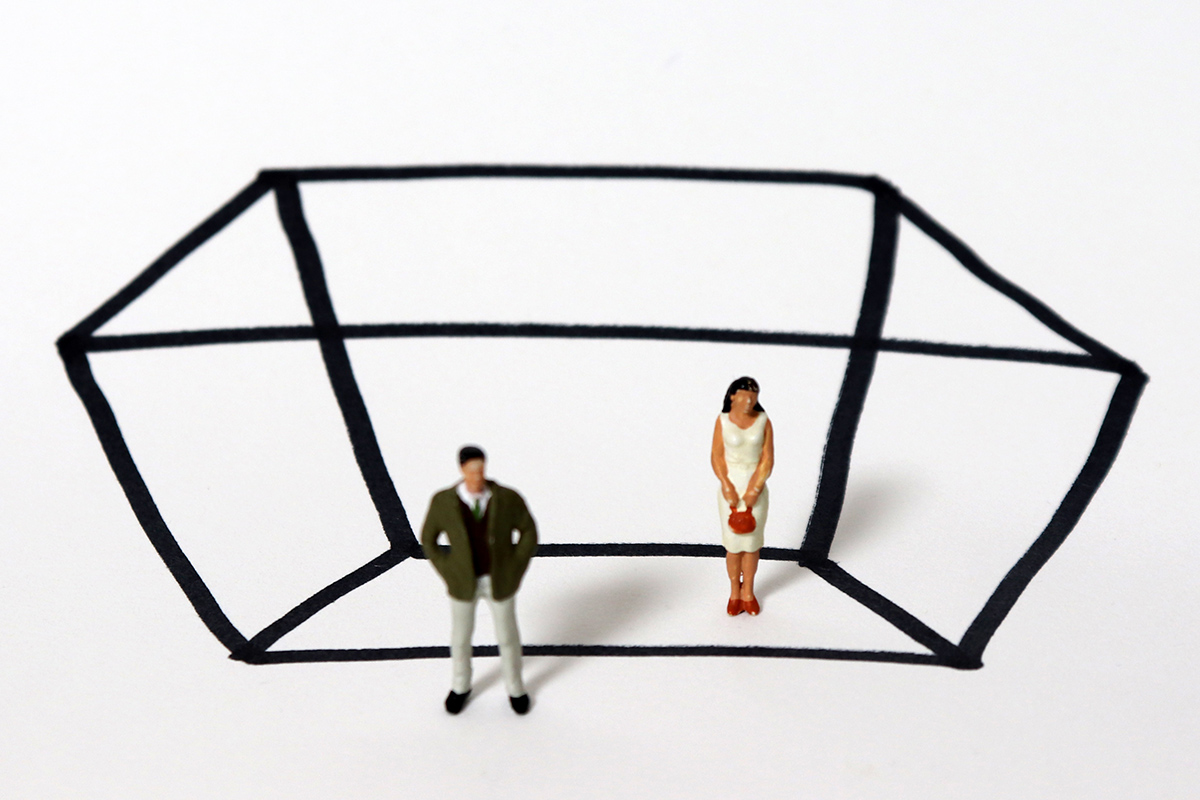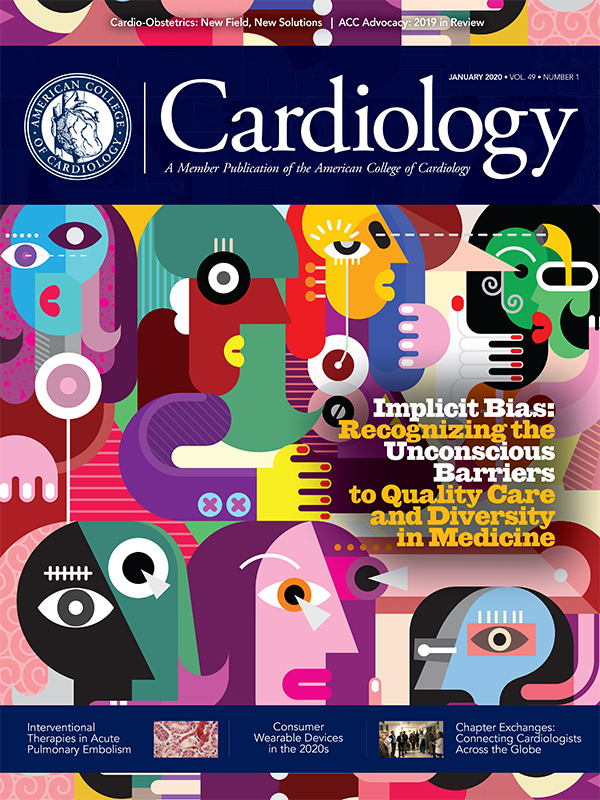Cover Story | Implicit Bias: Recognizing the Unconscious Barriers to Quality Care and Diversity in Medicine

Here's the thing about implicit bias: it's ubiquitous. Everyone, including physicians and other health care professionals, has implicit, also called unconscious, biases that affect how they view the world and interact with others.2
These are not the same as explicit biases, in which you're aware of the positive or negative attitudes you hold, but they can be just as powerful and in some cases damaging.
There are several definitions of implicit bias but all come down to the same thing: attitudes or decisions that lead to unintended disparities and inequalities and reinforce cultural biases, resulting in "unintended consequences."
To make it even more confounding, a person's implicit biases are often in conflict with their own beliefs about how they see the world.3
And yet, says Quinn Capers IV, MD, FACC, a professor of cardiovascular medicine at The Ohio State University College of Medicine Columbus and an expert on the topic of implicit bias, "although people tend to recoil when they hear the word 'bias' it doesn't mean you're a bad person. Good people can discriminate."
"Implicit bias is automatic and unconscious," says Ranna Parekh, MD, MPH, the ACC's chief diversity and inclusion officer. "It's so ingrained in someone that it is a reflexive response." Indeed, implicit bias begins at a very young age (pro-white bias has been observed in children as young as three years) because of repeated reinforcement of social stereotypes.3
"Over time," she says, "it becomes replicated and reinforced so often that we don't even see it as bias." And the biases aren't just about race or ethnicity, but about any minority status such as sexual orientation, gender, weight, age, socioeconomic status, disability and even height.1
The word "unconscious" reflects the reality of the bias. For instance, one study found that even researchers and doctors who specialize in obesity and understand that the condition has genetic and environmental causes still held implicit biases against obese people, associating them with being lazy, stupid and worthless.4
Why Do We Have Implicit Biases?
If implicit biases can be so damaging, then why do they exist? Evolutionary psychologists believe we developed implicit bias as a protective mechanism, Capers says.
"The first time a human saw an animal they didn't know, they just naturally assumed it was dangerous," he adds. The thought could be: "If I don't know what that is and it doesn't look like me or those I know, then I'm going to stay away." This was a good thing in those days, not so much in 2020.
"Now if I'm sitting across the table from a young woman wearing the hijab or some necklace that I don't understand, our brains are still hard wired to say she doesn't look like me or anyone I have a good time with so I should be suspicious and keep away," says Capers.
Implicit Bias in Medicine
Implicit biases affect patient care, medical school admissions, faculty hiring, promotion and growth opportunities.5,6
It is at the heart of disparities in medicine. Such disparities are particularly prevalent in cardiovascular medicine, in which African-Americans are less likely than whites to receive evidence-based care for stroke, myocardial infarction and heart failure.7
One reason is that white physicians, particularly males, associate black patients with being uncooperative and noncompliant, which may limit the extent and quality of the care they receive.3
Other instances of implicit bias affecting patient care include:
- Black and Hispanic patients are significantly less likely than whites to receive pain medications, even for acute injuries like bone fractures. When they do receive analgesics, they are at lower dosages than white patients despite having higher pain scores.8,9
- Physicians are less likely to treat suicidal ideation in elderly patients despite the fact that those 85 and older have the second highest rate of suicide of any age group.10,11
- Women are three-times less likely to be referred for total knee replacement than men even when clinically indicated, and are less likely to be diagnosed with COPD than men despite having similar histories and medical examinations.3

Health care disparities are also the result of a less diverse medical workforce, which Capers calls a "national emergency."
In 2018, for instance, just 4 percent of the 2,917 cardiology residents in the U.S. were black and just 4.8 percent were Hispanic. And while half of all medical students are women, just 22 percent continue on to a cardiology fellowship.12 Which explains why cardiology ranks 36 of 44 specialties for the percentage of women.13
"Unconscious bias is damaging to women," says Khanjan Shah, MD, an interventional cardiologist at the University of Florida School of Medicine in Gainesville and associate fellow of ACC who studies gender bias in medical school and cardiology training. "And the fact that it is unconscious is perhaps even more damaging because open discussion of the issue is stifled by lack of insight or frank denial."
For instance, she says, "When we look at the numbers and see that pediatricians, allergists and dermatologists are predominantly women, our first thought might be: maybe women enjoy these fields more. But a close second thought should be: Are women nudged into these fields by biases rooted deep into the structure of our education and training? And if the answer is yes or even perhaps, then we need to study bias and fix the system."
Such gender biases can turn up in the most unexpected places. Sharonne N. Hayes, MD, FACC, professor of cardiovascular medicine at Mayo Clinic in Rochester, MN, has more than 100 publications to her name. Yet she points to a study she published in 2017 as the "most gratifying" of her career.
She and her colleagues analyzed how 321 speakers were introduced during grand rounds at Mayo Clinic. They found that when a woman was introducing a speaker, nearly all used professional titles for both male and female speakers, but when a man was introducing a speaker, there was only a 50:50 likelihood that a female speaker would be introduced as "doctor."14
"I'm fine being called 'Sharonne' if the guys are called Bob and Bill," she says, "but not if I'm 'Sharonne' and they are Dr. Jones and Dr. Smith."
Hayes never believed her colleagues were deliberately introducing women differently from men, assuming it was due to unconscious biases. Nonetheless, it still bothered her and her coauthors, she says.
When the study was published in the Journal of Women's Health, "we were so gratified by the response from colleagues," Hayes says. "They'd say they'd never noticed it, but didn't doubt the data and now can't unhear it when it happens."
Since the study, Mayo has written new guidelines for introductions to ensure equity.
In addition, the findings have been replicated in other studies; most recently one from the American Society of Clinical Oncologists (ASCO) found similar gender biases when women were introduced by males during ASCO's 2017 and 2018 meetings as well as racial biases when black speakers were introduced.15

Implicit Bias in Medical School and the Workplace

"Our physician workforce doesn't even come close to representing the diversity in our country," Capers says. "At every step of the way of becoming a physician someone is looking at you and a group of other applicants and deciding who will go forward and who won't," and every one of those decisions involves implicit bias. It starts with job descriptions and letters of recommendation. For instance, the phrase "a strong, charismatic leader," in a job description implies a man; whereas a more specific description, such as "a physician-scientist who has led a federally funded research program for over 10 years and participated in the profession at a national level" reduces that male candidate image.16
Letters of reference, which are weighted heavily for medical school, residency and fellowship admissions, are also prone to bias. In one study, researchers analyzed 332 letters of recommendation for 89 urology residency applicants (half male, half female), in which 86 percent of the letter writers were men.
They found that letters for male applicants had significantly higher word counts; standout adjectives such as "exceptional"; and references to awards, achievement, ability, hardship, leadership. They also used the applicant's name more often.17
Meanwhile, letters for female applicants were more likely to have positive general terms such as "delightful," and grindstone words such as "hard working."
They also used physical descriptions and included softer words such as care, time, patients and support. Letters for male applicants, however, were more likely to include achievement terms, such as performance, career and knowledge. None of these disparities existed when women wrote the letters.
The more certainty and power words contained within the letter, the more likely the applicant was to match. Such studies led Hayes to investigate her own biases when writing letters of recommendation.
"I think I write good letters but now I'm very proactive about using more agentic than communal terms, particularly when talking about women."
She and her team are now replicating their own letters of recommendation study.
Capers led his own study into the effects of implicit bias on medical school admissions, administering the Harvard Implicit Association Test (IAT), the gold standard when it comes to measuring implicit bias, to the 140 members of the admissions committee.

The results showed significant levels of white preference, with the magnitude of bias twice as high in men than women, and also higher in faculty members vs. medical students (the researchers didn't break out the results by race because they didn't want any identifiable information).18
When they announced the results during the committee's annual all-day retreat, there was silence, he recalled. Then the reactions began, with many questioning the findings. But Capers was prepared. He'd brought in one of the foremost experts on implicit bias to explain the results, what they meant, and discuss opportunities to mitigate bias.
"It sunk in," he says. A post-retreat survey found that 67 percent of participants thought the IAT might be helpful in reducing bias, 48 percent were now conscious of their individual results when interviewing candidates, and 21 percent said their own results had an impact on their admissions decisions in the next cycle.
The retreat was held at the beginning of the admission cycle and that year's class was the most diverse in the medical school's history, Capers says. Interestingly, it wasn't because more minorities and women were accepted, but because more students who were accepted decided to matriculate.
"We know from social psychology research that biases affect how you interact with those you're biased against," Capers says. This includes talking over the other person, smiling less and making less eye contact. "Imagine how you feel if you're on the other end of that interaction."
Thus, his theory is that after undergoing the implicit bias training committee members interacted differently with applicants and the applicants sensed a more inclusive environment. The results have held, he says, and each year since the class has gotten more representative of the general population.
Recognizing Your Own Biases

Even the experts in implicit bias have their own biases. Capers, who is African-American and has family in Alabama, admits to a bias against white people with deep Southern drawls.
"My mind unconsciously associates it with 'this person is not only different from me, but does not have my best interest at heart because of the history of oppression against African-Americans in this country," he shares.
The bias comes from watching films about the South and interactions when he visited his grandparents in Alabama. Being aware of it, however, means he has developed approaches to reduce its impact on his interactions.
For instance, he tries to find a common identity with the person (i.e., they both like music), and to consider the opposite of what he's thinking.
Hayes shares the story of a colleague who is an orthopedic surgeon who has unconscious bias against obese people. The surgeon recognized it, however, and developed a strategy to mitigate its impact on her patients.
Before entering an examining room, the surgeon reviews the patient's body mass index. If the patient is obese, it turns on a "yellow light," Hayes says, so her brain "doesn't get hijacked" into a decision that may be based on that bias rather than the patient's condition.
To identify your own implicit biases, you can take the IAT online at implicit.harvard.edu.
Mitigating Implicit Bias

Although you can't eliminate your implicit biases (they're as much a part of you as your DNA) you shouldn't take a nihilistic view and assume there's nothing to be done.
"We want to send a hopeful message," Hayes says. "You can put the tools in place to address this, you can advocate for others and for change in the health care system, and you can take care of yourself so it doesn't happen that easily." What you can't do is ignore it. "The status quo is not okay."
Research finds that this approach – recognizing your own implicit biases and then receiving training in managing them – can make a significant impact.
For instance, a study of gender bias at the University of Wisconsin-Madison found that when at least a quarter of the faculty in a department attended a 2.5-hour interactive workshop on the topic, there were significant increases in self-reported actions to promote gender equity at three months.19
Joanna Lane, a consultant who provides diversity and inclusion training and leadership coaching to organizations, including the ACC, says her goal is to help "shine a light" so her clients have consciousness around their own biases and can work to create a more inclusive culture.

One tool she suggests is making yourself accountable to the people around you.
"Let other people know you are aware of your tendencies or biases and ask them to tell you if they see it affecting your interactions with certain people or decisions you're making. It can have a profound effect once you engage in conversation and inspire others to think about their own biases."
Capers highlights the following validated approaches:
- Find a common shared interest. Ask the person questions about interests and activities that you share in common, such as family size, community, and common hobbies or sports.
- Take the other person's perspective. "Really try to get inside their head and their life and walk a mile in their shoes," Capers said during his keynote speech at the 2019 annual meeting of the American College of Chest Surgeons.
"I have to think, what did this person have to do to get to me today? Maybe they had to make arrangements at work two weeks in advance. Maybe they had to find child care. Then they get here and have to figure out where to park their car. It's all pretty stressful. If I contemplate that, I develop empathy for them, and that is the key."20 - Consider the opposite. When data seem to point to one conclusion, briefly look for data supporting the opposite conclusion before making a final decision.20
- Counter stereotypes. This means spending time with individuals you admire from groups you have a bias against to help you gain a greater understanding of the differences.

Hayes stresses the importance of evidence-based medicine in the clinical setting and using checklists and standardized order sets.
"A lot of physicians say that's cookbook medicine, but I would argue that sometimes the cookbook makes for a very good recipe," she says. "You can always modify treatment when indicated, but these supports cover the basics."
For instance, "If I want to make sure I don't undertreat a woman or a Hispanic patient after a myocardial infarction who doesn't speak English, a standardized dismissal order set with guideline-based recommendations makes it easy for me to do the right thing."
Also keep in mind that the people who are most likely to be victims of unconscious bias are those lower on the hierarchy scale, Hayes says, whether that means patients, medical students, residents or early career faculty.
"This means those of us who have the higher status and privilege need to be leaders in this," Hayes says. "Hospital CEOs and department chairs need to talk about this and why it is so important in their practice, for their patients, and for the future workforce."

- Glicksman E. Unconscious Bias in Academic Medicine: Overcoming the Prejudices We Don't Know We Have. AAMC News. Sept. 27, 2016. Available here. Accessed Dec. 6, 2019.
- Sabin J, Nosek BA, Greenwald A, Rivara FP. Physicians' implicit and explicit attitudes about race by MD race, ethnicity, and gender. J Health Care Poor Underserved 2009;20:896-913.
- Chapman EN, Kaatz A, Carnes M. Physicians and implicit bias: how doctors may unwittingly perpetuate health care disparities. J Gen Intern Med 2013;28:1504-10.
- Schwartz MB, Chambliss HO, Brownell KD, et al. Weight bias among health professionals specializing in obesity. Obes Res 2003;11:1033-9.
- Byington CL, Lee V. Addressing disparities in academic medicine: Moving forward. JAMA 2015;314:1139-41.
- Smedley BD, Stith Butler A, Bristow LR. In the Nation's Compelling Interest: Ensuring Diversity in the Health-Care Workforce. Washington, DC: National Academies Press; 2004.
- Mayberry R, Boone L. Racial/Ethnic Differences in Cardiac Care: The Weight of the Evidence. Kaiser Family Foundation; American College of Cardiology;October 2002, Available here. Accessed Dec. 15, 2019.
- Mossey JM. Defining racial and ethnic disparities in pain management. Clin Orthop Relat Res 2011;469:1859-70.
- Todd KH, Samaroo N, Hoffman JR. Ethnicity as a risk factor for inadequate emergency department analgesia. JAMA 1993;269:1537-9.
- Uncapher H, Arean PA. Physicians are less willing to treat suicidal ideation in older patients. J Am Geriatr Soc 2000;48:188-92.
- American Foundation for Suicide Prevention. Suicide Statistics Available here. Accessed Dec. 15, 2019.
- Accreditation Council for Graduate Medical Education. Data Resource Book: Academic Year 2017-2018. 2019.
- American College of Cardiology. American College of Cardiology Diversity and Inclusion Initiative. 2017.
- Files JA, Mayer AP, Ko MG, et al. Speaker Introductions at internal medicine grand rounds: Forms of address reveal gender bias. J Womens Health 2017;26:413-9.
- Duma N, Durani U, Woods CB, et al. Evaluating unconscious bias: Speaker introductions at an international oncology conference. J Clin Oncol 2019;37(15_suppl):10503-10503.
- Carnes M, Bairey Merz CN. Women are less likely than men to be full professors in cardiology: Why does this happen and how can we fix it? Circulation 2017;135:518-20.
- Filippou P, Mahajan S, Deal A, et al. The presence of gender bias in letters of recommendations written for urology residency applicants. Urology 2019;134:56-61.
- Capers QI, Clinchot D, McDougle L, Greenwald AG. Implicit racial bias in medical school admissions. Acad Med 2017;92:365-9.
- Carnes M, Devine PG, Baier Manwell L, et al. The effect of an intervention to break the gender bias habit for faculty at one institution: a cluster randomized, controlled trial. Acad Med 2015;90:221-30.
- Everyday solutions to reduce implicit bias in health care. Helio Pulmonology Oct. 21, 2016. Available here. Accessed Dec. 15, 2019.
Clinical Topics: Acute Coronary Syndromes, Anticoagulation Management, Arrhythmias and Clinical EP, Cardiac Surgery, Congenital Heart Disease and Pediatric Cardiology, Diabetes and Cardiometabolic Disease, Dyslipidemia, Geriatric Cardiology, Heart Failure and Cardiomyopathies, Invasive Cardiovascular Angiography and Intervention, Noninvasive Imaging, Pericardial Disease, Prevention, Pulmonary Hypertension and Venous Thromboembolism, Sports and Exercise Cardiology, Stable Ischemic Heart Disease, Valvular Heart Disease, Vascular Medicine, Anticoagulation Management and ACS, Implantable Devices, SCD/Ventricular Arrhythmias, Atrial Fibrillation/Supraventricular Arrhythmias, Cardiac Surgery and Arrhythmias, Cardiac Surgery and CHD and Pediatrics, Cardiac Surgery and Heart Failure, Cardiac Surgery and SIHD, Cardiac Surgery and VHD, Congenital Heart Disease, CHD and Pediatrics and Arrhythmias, CHD and Pediatrics and Imaging, CHD and Pediatrics and Interventions, CHD and Pediatrics and Prevention, Acute Heart Failure, Pulmonary Hypertension, Interventions and ACS, Interventions and Imaging, Interventions and Structural Heart Disease, Interventions and Vascular Medicine, Angiography, Nuclear Imaging, Hypertension, Sleep Apnea, Sports and Exercise and Congenital Heart Disease and Pediatric Cardiology, Sports and Exercise and ECG and Stress Testing, Sports and Exercise and Imaging, Chronic Angina
Keywords: ACC Publications, Cardiology Magazine, Acute Coronary Syndrome, Anticoagulants, Arrhythmias, Cardiac, Cardiac Surgical Procedures, Metabolic Syndrome, Angina, Stable, Heart Defects, Congenital, Dyslipidemias, Geriatrics, Heart Failure, Angiography, Diagnostic Imaging, Pericarditis, Secondary Prevention, Hypertension, Pulmonary, Sleep Apnea Syndromes, Sports, Angina, Stable, Exercise Test, Heart Valve Diseases, Aneurysm
< Back to Listings

